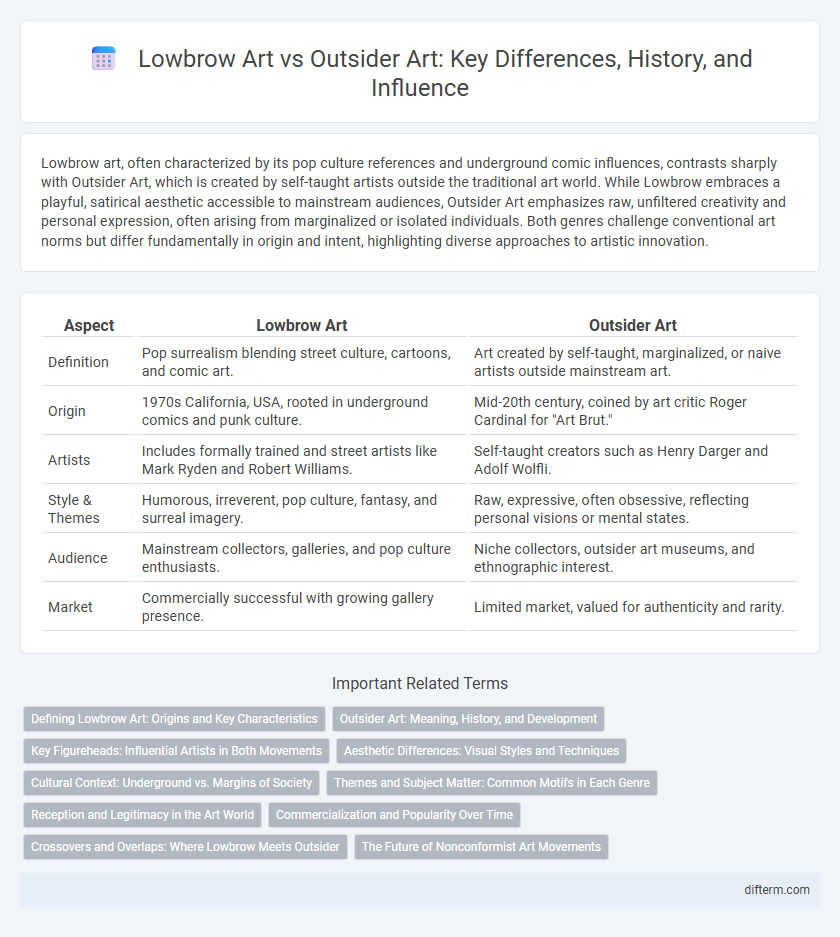Lowbrow art, often characterized by its pop culture references and underground comic influences, contrasts sharply with Outsider Art, which is created by self-taught artists outside the traditional art world. While Lowbrow embraces a playful, satirical aesthetic accessible to mainstream audiences, Outsider Art emphasizes raw, unfiltered creativity and personal expression, often arising from marginalized or isolated individuals. Both genres challenge conventional art norms but differ fundamentally in origin and intent, highlighting diverse approaches to artistic innovation.
Table of Comparison
| Aspect | Lowbrow Art | Outsider Art |
|---|---|---|
| Definition | Pop surrealism blending street culture, cartoons, and comic art. | Art created by self-taught, marginalized, or naive artists outside mainstream art. |
| Origin | 1970s California, USA, rooted in underground comics and punk culture. | Mid-20th century, coined by art critic Roger Cardinal for "Art Brut." |
| Artists | Includes formally trained and street artists like Mark Ryden and Robert Williams. | Self-taught creators such as Henry Darger and Adolf Wolfli. |
| Style & Themes | Humorous, irreverent, pop culture, fantasy, and surreal imagery. | Raw, expressive, often obsessive, reflecting personal visions or mental states. |
| Audience | Mainstream collectors, galleries, and pop culture enthusiasts. | Niche collectors, outsider art museums, and ethnographic interest. |
| Market | Commercially successful with growing gallery presence. | Limited market, valued for authenticity and rarity. |
Defining Lowbrow Art: Origins and Key Characteristics
Lowbrow Art, also known as pop surrealism, emerged in the late 1970s Los Angeles underground scene, blending elements of punk, comic books, and hot-rod culture. It is characterized by its vivid imagery, humor, and accessible themes, often challenging traditional fine art boundaries. Unlike Outsider Art, which originates from self-taught artists outside the conventional art world, Lowbrow Art embraces a more polished aesthetic influenced by popular media and subcultural iconography.
Outsider Art: Meaning, History, and Development
Outsider Art refers to creations made outside the boundaries of official culture, often by self-taught or marginalized artists lacking formal training. Emerging in the early 20th century, the term was popularized by art critic Roger Cardinal in 1972, building upon Jean Dubuffet's concept of Art Brut, which celebrated unrefined, raw artistic expression. The development of Outsider Art has emphasized individuality and raw creativity, influencing contemporary art by challenging traditional aesthetics and institutional norms.
Key Figureheads: Influential Artists in Both Movements
Lowbrow art features influential artists like Robert Williams and Mark Ryden, known for blending pop culture with surrealist imagery. Outsider art highlights figures such as Henry Darger and Judith Scott, celebrated for their raw, self-taught creativity outside mainstream art institutions. Both movements challenge traditional art boundaries through distinct visionary expressions and cultural narratives.
Aesthetic Differences: Visual Styles and Techniques
Lowbrow art features vibrant colors, pop culture references, and a polished, cartoon-like aesthetic emphasizing humor and irony. Outsider art is characterized by raw, untrained techniques, spontaneous creativity, and often unconventional materials, resulting in more primal and expressive visuals. The contrasting aesthetics highlight Lowbrow's cultural commentary versus Outsider art's introspective, untamed expression.
Cultural Context: Underground vs. Margins of Society
Lowbrow art, emerging from underground subcultures such as punk and skateboarding, reflects vibrant pop culture and satire rooted in urban environments. Outsider art originates from individuals outside mainstream art institutions, often created by self-taught artists on the margins of society, including psychiatric patients and recluses. These distinct cultural contexts shape Lowbrow as a rebellious, accessible movement, whereas Outsider art embodies raw, unfiltered creativity disconnected from conventional artistic norms.
Themes and Subject Matter: Common Motifs in Each Genre
Lowbrow art often explores pop culture, humor, and surrealism with motifs like cartoons, comics, and underground icons, embracing a rebellious and accessible aesthetic. Outsider art features raw, untrained creativity focusing on personal narratives, spirituality, and visionary experiences, frequently incorporating intricate patterns and unconventional materials. Both genres challenge traditional art norms but diverge in thematic focus, with Lowbrow emphasizing cultural critique and Outsider art highlighting individual expression and psychological depth.
Reception and Legitimacy in the Art World
Lowbrow art, emerging from underground comics and pop culture, has gained increased acceptance in galleries and mainstream art institutions, challenging traditional art hierarchies. Outsider art, created by self-taught artists outside the conventional art sphere, is often celebrated for its raw authenticity but struggles with consistent institutional recognition. Both genres face ongoing debates over legitimacy, with Lowbrow art bridging pop culture and fine art, while Outsider art emphasizes pure creative expression beyond artistic norms.
Commercialization and Popularity Over Time
Lowbrow art, originating in the 1970s California counterculture, has seen significant commercialization through galleries, merchandise, and media, gaining mainstream popularity and bridging the gap with pop culture. Outsider art, created by self-taught artists outside the commercial art world, remains less commercialized but has gradually attracted collectors and museums, increasing its visibility. The sustained growth of lowbrow art contrasts with outsider art's slow rise, reflecting different dynamics in market penetration and audience engagement.
Crossovers and Overlaps: Where Lowbrow Meets Outsider
Lowbrow art and outsider art intersect through their shared emphasis on authentic, unpolished creativity that challenges traditional art norms. Both genres embrace subcultural narratives and personal expression, often incorporating street art aesthetics and unconventional materials. This crossover fosters a dynamic dialogue that blurs the boundaries between self-taught outsider artists and the pop-culture-driven lowbrow movement.
The Future of Nonconformist Art Movements
Lowbrow art and Outsider art both challenge traditional art norms by embracing unconventional themes and techniques, yet their evolving boundaries signify a dynamic future for nonconformist art movements. The rise of digital platforms amplifies the visibility of these genres, fostering global communities that redefine artistic value beyond institutional validation. Emerging trends suggest a fusion of Lowbrow's pop culture references with Outsider art's raw authenticity, indicating a transformative trajectory for avant-garde creativity.
Lowbrow vs Outsider Art Infographic

 difterm.com
difterm.com